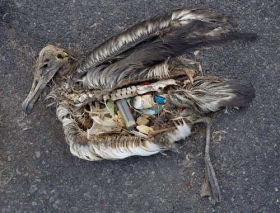Course:ECON371/UBCO2011WT1/GROUP2/Article 6 : Birds & The Great Pacific Garbage Patch
http://www.enn.com/wildlife/article/43504
Summary
Garbage debris in the pacific ocean have converged in one point in the pacific ocean to create what is referred to as the “Great Pacific Garbage Patch”. This garbage patch stretches for hundreds of miles, and is growing at a rapid rate, polluting the ecosystem with harmful trash. The debris are causing a huge problem for birds, making them die rapidly because they mistake the garbage for food and choke, become poisoned, or have a fatal blockage from consuming these plastics. The birds have been seen and photographed with their stomachs full of waste such as plastic bags, bottles and other types of human produced garbage. Another of these garbage patches has also been spotted in the Atlantic Ocean and the scope and damage of these patches is not yet known.
Analysis
The Great Pacific Garbage Patch is causing environmental concerns and direct damages to organisms in the ecosystem. Determining the amount of damage and the size of the patch is quite difficult however because of the distribution of the debris. The garbage is slightly under the surface of the water making it unobservable from surface of on satellites. This lack of visibility makes it necessary to do expensive and time consuming sampling to monitor the site which is less accurate. The lack of visibility also begs the question if more of these patches exist that we are not yet aware of especially because of the recent discovery of another patch in the Atlantic Ocean. The path of the debris is also unknown because most of the travel occurs below the surface in currents that are not traceable. With such little information about the impacts and size of these patches it is much more difficult to decide an efficient level of regulation and reduction.
The garbage patch has no clear source of emissions because of the way the garbage flows to get to the patches making directly controlling abatement impossible. To control the amount of garbage in the patch the direct emissions would need to be monitored and regulated. Controlling these levels opposed to direct abatement may be less efficient and may not directly correlate with the patches. These difficulties make choosing and approving programs very difficult and would face more industry objection because their emissions may not actually be contributing to the problem, creating inefficiency and dead weight loss.
If more information were available and a direct cost measurement of the reduction of litter to the ocean could be measured it would cause even more difficulty effectively measuring the benefits of pollution reduction. There would be a problem in the benefit side of monetary valuation because placing worth on ocean cleanliness is very difficult with much room for variation. If they were to use contingent the values would be most likely higher than the actual because it is difficult for people to conceptualize a cost they would not have to pay for. If hedonic valuation was used it would in turn be very low because the damages are not directly to people so they are most likely not currently paying to avoid the damages and they would likely be willing to pay more to avoid it. There will not be a substantial loss to biodiversity so the individual value of the deaths of several birds that are not at a significant risk of complete extinction is hard to measure. Items like this contribute to the debate of the legitimacy of monetization as a calculation of an items worth because you cannot really put a money value on the suffering and dying of birds into the ocean that does not directly effect another industry.
Prof's Comments
There are certainly valuation challenges. There is also a serious policy challenge. I see this as a very good example of a public goods problem. Addressing this problem requires action on the part of all sources around the world. However, because any nation acting to reduce plastics use in their own nation suffers the full cost of doing so, but receives only a portion of the benefit, in terms of the value of a reduction in the amount of garbage, every one has an incentive to free ride.
Also, there is a pretty strong hint at moral suasion. The article talks about the photographer who has been documenting and publicising the damage. This seems to be an attempt to get people upset, and thereby change policy.
6.5/10
